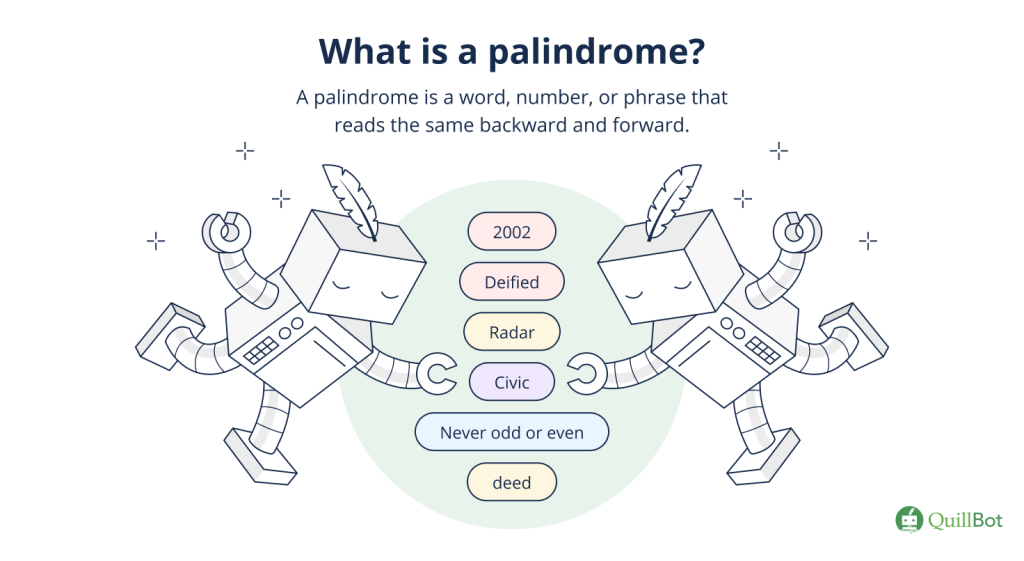When people first hear the word palindrome, they often think of words like level, radar, or madam. But palindromes aren’t limited to words alone—they exist in numbers too. A palindrome number is a number that remains the same when its digits are reversed.
Palindrome numbers have fascinated mathematicians, computer scientists, and puzzle enthusiasts for decades. They are simple to define, yet they lead to surprisingly complex problems in number theory, algorithms, and applications.
In this comprehensive guide, we will dive deep into palindrome numbers, exploring their meaning, significance, properties, applications, and real-time coding implementations.
What is a Palindrome Number?
A palindrome number is a numerical value that reads the same backward and forward. For example:
- 121 → Reversed digits = 121 (Palindrome)
- 12321 → Reversed digits = 12321 (Palindrome)
- 1234 → Reversed digits = 4321 (Not a palindrome)

Formal Definition:
If a number n has digits such that reversing its order produces the same number, then n is called a palindrome number.
Mathematical Expression:
Let n = d₁d₂…dₖ (digits of n). If d₁d₂…dₖ = dₖ…d₂d₁, then n is a palindrome.
Real-World Examples of Palindrome Numbers
Palindrome numbers are not just theory—they appear around us frequently:
- Dates: 02/02/2020 was a palindrome date.
- License Plates: Many vehicle numbers are palindrome-friendly for easy recall.
- Bank Transactions: Transaction IDs sometimes use palindromes for test cases.
- Mathematics Puzzles: Many competitive exams feature palindrome problems.
History and Origin of Palindrome Concept
The concept of palindromes can be traced back to ancient civilizations. While word-based palindromes were popular in Greek and Latin poetry, numerical palindromes appeared in recreational mathematics texts.
In India, palindrome patterns were studied in Sanskrit poetry, where numeric palindromes symbolized symmetry and balance. In modern times, palindrome numbers are an integral part of mathematics and computer algorithms.
Why Palindrome Numbers Matter in Mathematics and Computing
Palindrome numbers are important for several reasons:
- Mathematical Interest: They are part of number theory and recreational mathematics.
- Symmetry: Palindromes demonstrate numerical symmetry, which is vital in cryptography.
- Programming Practice: Checking palindrome numbers is a common beginner’s coding problem.
- Data Integrity: Palindrome logic can help verify data accuracy in systems.
Key Properties of Palindrome Numbers
- A single-digit number is always a palindrome.
- A number with an even number of digits can be a palindrome (e.g., 1221).
- A number with an odd number of digits can also be a palindrome (e.g., 12321).
- Palindrome numbers remain unchanged when reversed.
- Palindrome numbers are non-negative in most practical definitions.
Step-by-Step Method to Check Palindrome Numbers
Algorithm Approach:
- Take the input number n.
- Reverse the digits of n.
- Compare the reversed number with the original.
- If equal → Palindrome. Else → Not a palindrome.
Example:
Input: 121
Reverse: 121
Output: Palindrome
Palindrome Number in Different Programming Languages
Python Example
def is_palindrome(num):
return str(num) == str(num)[::-1]
print(is_palindrome(121)) # True
print(is_palindrome(123)) # False
Java Example
class Palindrome {
public static void main(String[] args) {
int num = 121, reversed = 0, temp = num;
while(num > 0) {
int digit = num % 10;
reversed = reversed * 10 + digit;
num /= 10;
}
System.out.println(temp == reversed ? "Palindrome" : "Not Palindrome");
}
}
C++ Example
#include<iostream>
using namespace std;
int main() {
int num = 12321, rev = 0, original = num;
while(num > 0) {
int digit = num % 10;
rev = rev * 10 + digit;
num /= 10;
}
if(original == rev)
cout << "Palindrome";
else
cout << "Not Palindrome";
}
JavaScript Example
function isPalindrome(num) {
return num.toString() === num.toString().split("").reverse().join("");
}
console.log(isPalindrome(121)); // true
console.log(isPalindrome(456)); // false
Applications of Palindrome Numbers in Real Life
- Cryptography: Symmetric number properties aid secure encryption.
- Data Validation: Checking reversibility ensures integrity in communication systems.
- Computer Algorithms: Palindrome-based patterns improve string manipulation logic.
- Mathematics Puzzles: Used in coding competitions and problem-solving exercises.
Palindrome Number in Number Theory
In mathematics, palindrome numbers occupy a niche in recreational number theory. They exhibit unique properties that challenge the boundaries of integer analysis.
- Palindrome Primes: These are numbers that are both prime and palindrome. For example:
- 2, 3, 5, 7, 11, 101, 131, 151, 181, 191, 313…
Palindrome primes are finite within a digit range but infinite in the long run. They hold significance in cryptography due to their dual properties.
- 2, 3, 5, 7, 11, 101, 131, 151, 181, 191, 313…
- Palindromic Squares: Some squares of integers form palindromes. Example:
- 11² = 121
- 26² = 676
- 101² = 10201
- 11² = 121
- Palindromic Cubes: Similarly, cubic palindromes exist. Example:
- 11³ = 1331
- 101³ = 1030301
- 11³ = 1331
These properties fuel mathematical research in integer sequences. The OEIS (Online Encyclopedia of Integer Sequences) catalogs several such sequences for deeper analysis.
Palindrome Numbers in Modular Arithmetic
When working with modular arithmetic, palindrome numbers behave in interesting ways:
- For base b, any number that is a palindrome in base 10 may not be a palindrome in base b.
- Example: 585 is a palindrome in base 10 and base 2 (1001001001). Such numbers are called dual-base palindromes.
- Dual-base palindromes are especially rare and hold importance in cryptography, where multi-base number representations are critical.
Algorithmic Optimization for Palindrome Detection
For very large datasets or high-performance applications, brute force methods (digit reversal) may be inefficient. Here are some advanced approaches:
Mathematical Reversal Without String Conversion
Instead of converting to a string, reverse digits mathematically to save memory.def is_palindrome(num):
if num < 0:
return False
original, reversed_num = num, 0
while num > 0:
reversed_num = reversed_num * 10 + num % 10
num //= 10
return original == reversed_num
- Half-Reversal Optimization
Instead of reversing the entire number, reverse only half.
- Example: For 12321 → Compare first half 123 and reversed second half 321.
- Example: For 12321 → Compare first half 123 and reversed second half 321.
- Parallel Processing in Large Datasets
When searching for palindrome numbers across millions of records, parallelizing the palindrome check using frameworks like Apache Spark or Dask drastically improves performance.
Palindrome Numbers in Machine Learning
Although palindromes seem like pure math, they contribute indirectly to machine learning:
- Data Augmentation: Palindromic patterns can test the robustness of models in NLP or sequence learning tasks.
- Sequence Analysis: Recurrent Neural Networks (RNNs) often use palindrome-based datasets to check sequence memory.
- Anomaly Detection: Since palindromes are rare in large datasets, they can serve as outlier markers.
Palindrome Number in Cryptography
Palindrome numbers are useful in encryption schemes because:
- They demonstrate symmetry, useful in mirror-based encryption algorithms.
- Palindrome primes are hard to factorize when they get large, making them suitable for key generation.
- In hash functions, palindrome checks can act as validation filters.
Example: In blockchain validation, palindromes can test pseudo-random ID sequences.
Palindrome Problems in Competitive Programming
In programming contests (like Codeforces, LeetCode, HackerRank), palindrome number problems appear frequently. Examples include:
- Find the nearest palindrome:
Given a number, find the closest palindrome (e.g., for 123 → 121). - Palindrome Partitioning:
Break a number into palindrome subsequences. Example: 12321 → [1, 232, 1]. - Palindrome Multiplication:
Find the largest palindrome made by multiplying two n-digit numbers.
- Example: Largest 2-digit palindrome product = 9009 (91 × 99).
- Example: Largest 2-digit palindrome product = 9009 (91 × 99).
- Palindrome Addition Problem (196-algorithm):
Start with any number and keep adding its reverse until you reach a palindrome. Example:
- 89 + 98 = 187
- 187 + 781 = 968
- 968 + 869 = 1837
- Repeat until palindrome found (rarely infinite loops occur).
- 89 + 98 = 187
Palindrome Number in Data Science
Palindrome checks extend into data cleaning and validation:
- Data Quality: Palindromes are used in synthetic dataset creation to test edge cases.
- Error Detection: A transmission system using palindromic identifiers makes it easier to detect corrupt sequences.
- Pattern Recognition: Machine learning models trained on palindromic vs. non-palindromic numbers sharpen classification accuracy.
Palindrome Numbers in Real-Life Technology
- Digital Systems: Palindrome timestamps like 21:12:12 are used in system diagnostics.
- Database Management: Palindromic IDs reduce collision probability in distributed systems.
- Software Testing: Palindrome-based test cases check for string reversal bugs.
- Gaming: Many puzzle games embed palindrome challenges as Easter eggs.
Beyond Decimal – Palindrome Numbers in Other Bases
- In binary, palindromes include: 1 (1), 3 (11), 5 (101), 7 (111), 9 (1001).
- In hexadecimal, palindromes are more complex due to alphanumeric digits.
- Multi-base palindromes (same in base 2 and base 10) are extremely rare and researched in cryptography.
Advanced Research Areas
Palindrome numbers appear in advanced research areas:
- Automata Theory: Palindromes are used in constructing palindromic automata for string recognition.
- Computational Complexity: Palindrome detection is an O(n) problem, but palindrome product search may be NP-hard in higher ranges.
- Quantum Computing: Palindromic qubit states may enhance symmetry-based algorithms.
Real-World Case Study
In bioinformatics, DNA strands often exhibit palindromic sequences. For example:
- DNA palindrome: GAATTC → Reverse complement = CTTAAG
- These palindromic structures play a role in genetic regulation and are studied for drug discovery.
Palindrome number research has directly inspired palindromic sequence detection in biology, creating a bridge between mathematics, computing, and life sciences.
Palindrome Numbers and Human Fascination
Humans are naturally drawn to symmetrical patterns. Palindrome numbers are celebrated:
- Palindromic Dates: Highly popular in culture (e.g., 12-02-2021).
- Superstition: Some believe palindrome numbers are lucky and bring balance.
- Psychology: Palindromes are easy to remember, making them useful for branding and advertising.
Advanced Problems and Challenges with Palindrome Numbers
- Largest palindrome number product problem (e.g., product of two 3-digit numbers).
- Palindrome primes (numbers that are both prime and palindrome, like 131).
- Palindromic squares and cubes.
- Infinite sequence of palindromes problem.
Palindrome Numbers vs Palindrome Strings
- Palindrome Number: Deals with digits. Example: 1221.
- Palindrome String: Deals with characters. Example: “level”.
- Similarity: Both follow the same reversal logic.
Common Mistakes Learners Make While Coding Palindrome Numbers
- Forgetting to reset variables when checking multiple inputs.
- Using string conversion unnecessarily when integer-based logic is required.
- Not handling edge cases like negative numbers.
Conclusion
Palindrome numbers are not only intriguing but also essential for learning algorithms, symmetry, and real-world applications. From cryptography to competitive programming, palindromes remain a simple yet powerful concept.
Understanding palindrome numbers equips learners with strong problem-solving skills, prepares them for coding interviews, and deepens their appreciation of mathematical beauty.
FAQ’s
What is a palindrome number?
A palindrome number is a number that remains the same when its digits are reversed, such as 121 or 1331.
Is 1221 a palindrome?
Yes, 1221 is a palindrome because it reads the same forward and backward.
Are palindrome numbers lucky?
Palindrome numbers are often considered lucky or special in numerology and culture because their symmetry symbolizes balance, harmony, and good fortune. However, their “luckiness” depends on personal or cultural beliefs.
What is the largest 4-digit palindrome?
The largest 4-digit palindrome is 9999, since it reads the same forwards and backwards.
What is a super palindrome?
A super palindrome is a number that is a palindrome itself, and its square is also a palindrome. For example, 11 is a super palindrome because 11² = 121, and both 11 and 121 are palindromes.



